world.wikisort.org - Czech
Dobříš (Czech pronunciation: [ˈdobr̝iːʃ]; German: Doberschisch) is a town in Příbram District in the Central Bohemian Region of the Czech Republic. It has about 8,700 inhabitants. It is located 40 km (25 mi) south of Prague, and it is a part of the Prague metropolitan area.
Dobříš | |
|---|---|
Town | |
 Mírové Square | |
 Flag  Coat of arms | |
 Dobříš Location in the Czech Republic | |
| Coordinates: 49°46′52″N 14°10′2″E | |
| Country | |
| Region | Central Bohemian |
| District | Příbram |
| First mentioned | 1252 |
| Government | |
| • Mayor | Pavel Svoboda |
| Area | |
| • Total | 53.42 km2 (20.63 sq mi) |
| Elevation | 371 m (1,217 ft) |
| Population (2022-01-01)[1] | |
| • Total | 8,707 |
| • Density | 160/km2 (420/sq mi) |
| Time zone | UTC+1 (CET) |
| • Summer (DST) | UTC+2 (CEST) |
| Postal code | 263 01 |
| Website | www |
Administrative parts
The village of Trnová is an administrative part of Dobříš.
Geography
Dobříš is located about 15 kilometres (9 mi) northeast of Příbram and 31 km (19 mi) southwest of Prague. Most of the municipal territory lies in the Brdy Highlands, but the town proper lies entirely in the Benešov Uplands. The highest point is the hill Studený vrch at 660 metres (2,170 ft) above sea level.
In the town there is a set of ponds, fed by the Sychrovský stream and its tributary Trnovský stream. Notably, Huťský Pond is the location where muskrats, brought from North America, were first released in continental Europe.[2]
History
The settlement on the Golden Path trade route was first mentioned when in 1252 King Wenceslaus I of Bohemia signed a treaty with the Cistercian abbey of Plasy. Temporarily held by the noble House of Rosenberg, King John of Bohemia had a hunting lodge erected at Dobříš. It was devastated during the Hussite Wars in 1421.[3]
After the Kingdom of Bohemia had passed to the Habsburg monarchy, Dobříš was given market town rights by King Ferdinand I in 1543, confirmed by his son and successor Emperor Maximilian II in 1569. The Dobříš estate was acquired by the German House of Mansfeld in 1630. After the local castle and a large part of the town were damaged by a fire in 1720, the family had the castle rebuilt into a Rococo style chateau. The estate was inherited by the Austrian Colloredo-Mansfeld dynasty in 1780.[3]
Demographics
|
|
| ||||||||||||||||||||||||||||||||||||||||||||||||||||||
| Source: Censuses[4][5] | ||||||||||||||||||||||||||||||||||||||||||||||||||||||||
Economy
In the 19th century, the town became associated with the manufacturing of gloves, which began in 1865. This industry was first developed by Salamon Abeles. After World War II, a glove factory (Rukavičkářské závody) was still operating here.[3] The factory employed 3,300 people at its peak, but the production ended in 1992. Since 1993, the tradition is held by a small company NAPA.[6]
In the town centre and near the main road to Prague there are Bobcat factories.
Transport
The D4 motorway runs next to the town.
Sights

Dobříš Chateau is the most significant monument in the town. Its current appearance comes from the late 18th century, when the original Baroque castle was rebuilt.[7] Currently owned again by the noble family of Colloredo-Mansfeld, it is known as a fine example of Rococo architecture and for its gardens, including a French formal garden (one of the most popular in the country) and an English landscape garden.[8]
Notable people
- Josef Balabán (1894–1941), soldier and resistance fighter
- Jorge Amado (1912–2001), Brazilian writer; lived here
- Jan Drda (1915–1970), writer, journalist and politician; buried here
- Zélia Gattai (1916–2008), Brazilian writer; lived here
- Filip Dort (born 1980), footballer; lives here
Twin towns – sister cities
Dobříš is twinned with:[9]
 Geldrop-Mierlo, Netherlands
Geldrop-Mierlo, Netherlands Tonnerre, France
Tonnerre, France
References
- "Population of Municipalities – 1 January 2022". Czech Statistical Office. 2022-04-29.
- "Hrabě z Dobříše dovezl ondatry přes oceán, hlodavec obsadil celou Evropu" (in Czech). iDnes. 2020-04-21. Retrieved 2021-05-16.
- "Historie Dobříše" (in Czech). Město Dobříš. Retrieved 2021-05-16.
- "Historický lexikon obcí České republiky 1869–2011 – Okres Příbram" (in Czech). Czech Statistical Office. 2015-12-21. pp. 3–4.
- "Population Census 2021: Population by sex". Public Database. Czech Statistical Office. 2021-03-27.
- "Rukavičkářské závody v Dobříši mívaly 3.300 zaměstnanců. Dnes je rukavičkářské řemeslo na vymření" (in Czech). Czech Radio. 2018-07-12. Retrieved 2021-05-16.
- "Zámek Dobříš" (in Czech). Dobříš Castle. Retrieved 2022-01-10.
- "Zámek Dobříš – Dobříš Chateau" (in Czech). Město Dobříš. Retrieved 2021-05-16.
- "Partnerská města" (in Czech). Město Dobříš. Retrieved 2020-08-08.
External links
На других языках
[de] Dobříš
Dobříš anhören?/i (deutsch Doberschisch) ist eine Stadt in der Region Středočeský kraj (Tschechien). Auf 53,41 Hektar leben 7.915 Einwohner.- [en] Dobříš
Другой контент может иметь иную лицензию. Перед использованием материалов сайта WikiSort.org внимательно изучите правила лицензирования конкретных элементов наполнения сайта.
WikiSort.org - проект по пересортировке и дополнению контента Википедии